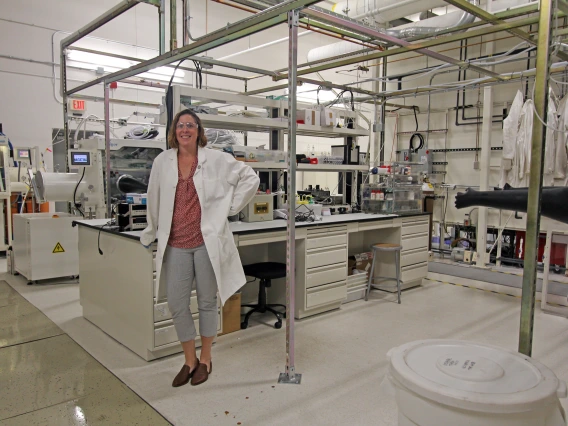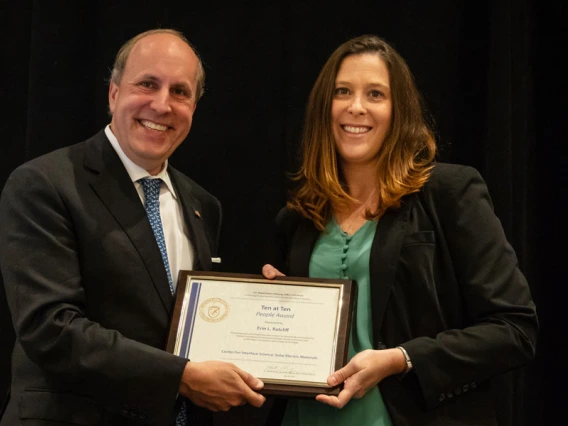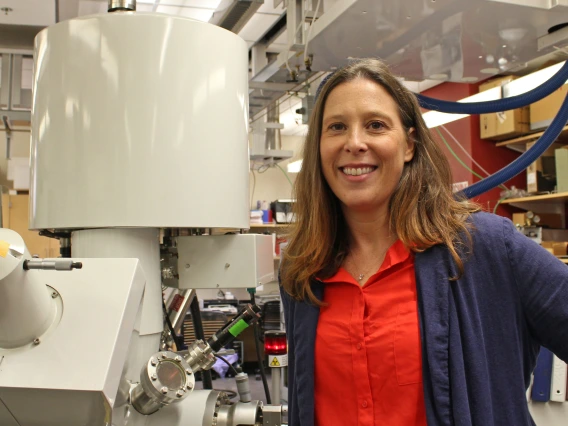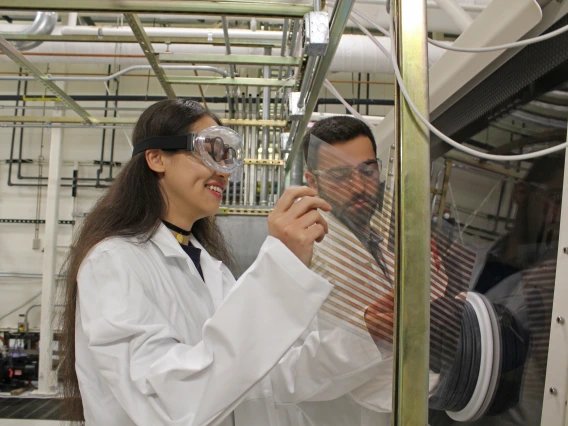Da Vinci Circle Selects Erin Ratcliff as 2023 Fellow
From a UA postdoc to a national center director, a chemical and environmental engineering professor has brought together disciplines and teams from across the nation to accelerate the pace of science.
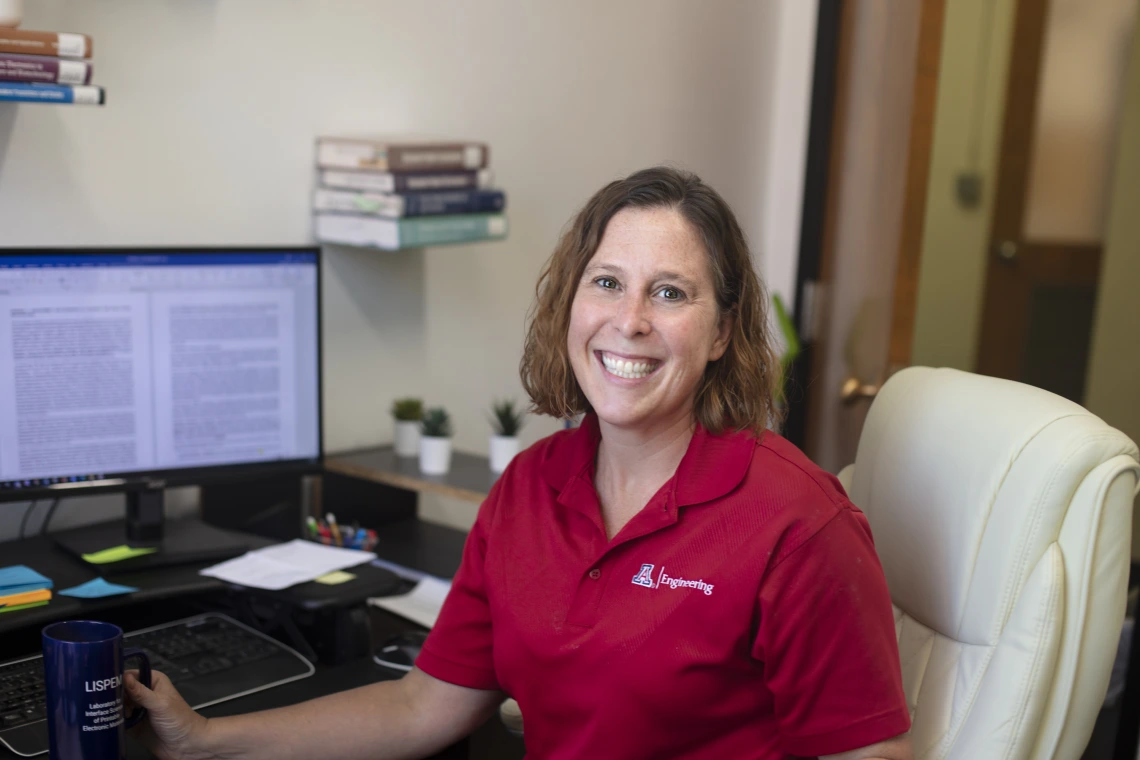
Erin Ratcliff, associate professor of chemical and environmental engineering and director of an Energy Frontier Research Center, is the College of Engineering's 2023 da Vinci Fellow.
Erin Ratcliff has always had the makings of a successful electrochemist and an interface scientist. As a child in Wisconsin, she used to make “super soaps” in her parents’ house.
“I would take all of the soaps and mix them together,” she said. “Which really just meant I made a super surfactant.”
Decades later, Ratcliff is an associate professor of chemical and environmental engineering and chemistry and biochemistry at the University of Arizona; the co-director of the Institute for Energy Solutions; and the director of the $10.95 million Center for Soft PhotoElectroChemical Systems, an Energy Frontier Research Center (EFRC) funded by the U.S. Department of Energy.
Most recently, Ratcliff, who also has a joint appointment at the National Renewable Energy Laboratory, was named the College of Engineering’s 2023 da Vinci Fellow. Generous donors to the college’s da Vinci Circle, which supports exceptional research in microtechnology, nanotechnology and biotechnology, select one faculty member each year as a fellow. The award comes with a one-time grant of $10,000.
“The da Vinci Fellowship is a huge honor,” Ratcliff said. “I’m so thrilled to have been selected. I’m among some very prestigious peers at the university. I plan to use the award to fund all my students and postdocs to go to a prestigious conference in North Carolina this summer.”
‘Actually Amazing’
As the director of the Laboratory for Interface Science of Printable Electronic Materials, Ratcliff focuses her research on the electrochemistry of low-cost, printable semiconducting materials and interfaces.
“Electrochemistry is really quite ubiquitous,” she said. “It’s involved in how our neurons transmit signals to one another. It’s involved in solar cells in the fundamental processes of converting sunlight into electricity. And so, you can take these different perspectives from one area, or one field, and apply them in a new way to create new types of printable electronic devices.”
This idea of blending perspectives is core to Ratcliff’s approach – in her own research, her work as a mentor and professor, and in her role as a lab and center director. She first joined the UA as a postdoctoral researcher in chemistry and biochemistry in 2007, where she was advised by Neal Armstrong, Regents Professor of chemistry and biochemistry and optical sciences. Armstrong began leading his own EFRC in 2009, and selected Ratcliff to coordinate efforts between center members across the country. She later received national recognition from the Department of Energy for her work.
“I knew in the first couple of weeks that she was going to be different than most of the other postdocs that I had,” Armstrong said. “She was not only doing very high-level science in my group, and mentoring students at the same time, but she was taking notes on how big, multidisciplinary science centers are organized. It was only natural that she was then going to wind up directing an EFRC.”
There have only been 104 EFRCs since they were first conceived in 2009, and the grants are highly competitive. Ratcliff’s center, known as SPECS, is focused on the molecular-level science behind low-cost, highly scalable soft semiconductor technologies, which could have implications for fields such as bioelectronics, health care and renewable energy. Ratcliff handpicked every member of the team from across eight institutions, including the University of Arizona, Purdue University and Stanford University.
“It’s actually amazing that she’s the head of this center,” said Kim Ogden, Department Chair of Chemical and Environmental Engineering. “Most of the time, centers like this are not run by associate professors at the time in their careers that she is. She has Regents Professors working with her, top scientists at Georgia Tech and the National Renewable Energy Lab. And she’s the principal investigator for all of this. This just isn’t normal.”
Building a Path for the Next Generation of Scientists
Ratcliff’s collaborators also commend her for incorporating diversity and inclusion efforts into her work. For her, it’s a no-brainer. Just as different types of electrochemistry projects can inform one another, and experts from different institutions can speed up scientific progress by working together, she says, diverse perspectives mean more efficient problem solving.
“It’s fantastic science. It’s cutting edge. It’s high risk. But it’s also integrated nicely with a sensitivity to broadening participation,” Armstrong said.
Ratcliff’s students say she always makes time to answer questions, despite her jam-packed schedule, and that her passion for the work is contagious.
“She is novel, she has a huge network, she’s published amazing papers, she’s leading centers: She just fits the mold of what a da Vinci Fellow is,” Ogden said.


